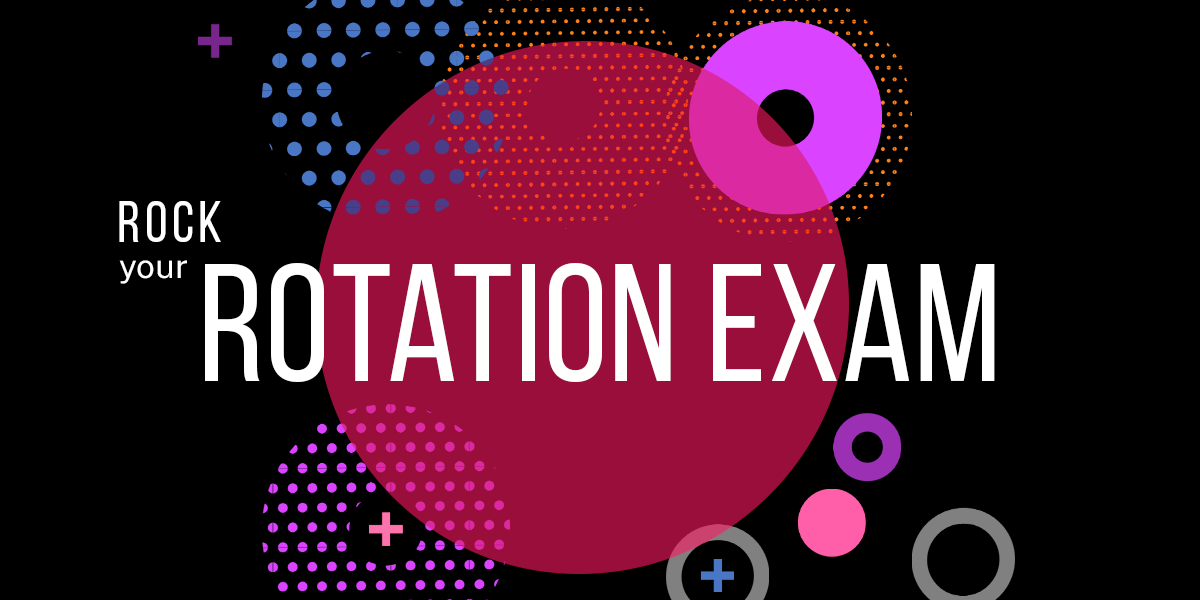How I Rocked My Pediatrics Rotation Exam

So you have to take the Pediatrics End of Rotation™ Exam (EOR™)…
Perhaps you have children, take care of a little one, or have no exposure to kids aside from the five weeks spent at your clinical site getting sneezed and urinated on. Either way, this article will hopefully help you prep for the daunting PAEA Pediatrics EOR™.
The best way to dispel my advice is to walk you through my personal experience and step-by-step approach to the test. In other words, to stay in line with our pediatric theme, please take a seat criss-cross applesauce, quiet your neighbor, and I will tell you the story of a tired, determined, and sometimes sniffly grad student planning, prepping, studying, and taking a whimsical multiple-choice exam about all things pediatric.
Look at the blueprint
Three to four weeks prior to my exam date, I went to the PAEA website to pull up the most up-to-date Pediatrics EOR™ blueprint and topic list. As you can see, the top two subjects are dermatology and HEENT—rashes and ear infections are key! Close runner-ups include infectious disease and pulmonology. Also worth noting on the blueprint stats is the exam’s tendency to concentrate on diagnostics and treatment strategies. I printed out the complete topic list and did an initial scan through to identify my strengths. At the same time, I highlighted topics that felt more foreign or far removed.
Make cheat sheets
Around this same time, I used old didactic notes and current clinical exposures to create a series of well-child check “cheat sheets.” I outlined all of the big-ticket items pertaining to sleep, feeding, and development at the regular age intervals (2 weeks, 4 months, 6 months, 9 months…all the way up to preteen years). I also used these cheat sheets to list out common vaccinations and screenings regularly performed at each visit. For example, at the average 12-month well-child check, the patient should be standing unassisted, babbling or imitating sounds, and waving goodbye. The 1-year-old child is due to receive PCV, Hib, MMR, VZV, and Hep A vaccinations. An initial lead and Hgb blood draw or POC test should also be performed.
Having this reference sheet for each well visit was not only helpful for my current clinical day-to-day but was also useful when it came down to crunch time for the exam.
Invest in resources
For each of the major body system topics, I referred to my old didactic notes, the PANCE Prep Pearls book by Dwayne Williams, the SmartyPANCE student portal (associated with PALife), and UpToDate. Of these resources, I purchased PANCE Prep Pearls and a year-long membership to SmartyPANCE.
Rosh Review is another resource I purchased and highly recommend! My classmates and I got a group deal on 12-month access to the Rosh Review portal and practice exam set. The user interface is aesthetically pleasing and easy to use. I specifically enjoy the “tutoring” mode where you can read about the correct answer and learn from your mistakes. Each question explanation during tutoring mode includes a short summary, illustration, and a quick mnemonic or buzz phrase. Rosh Review even outlines each incorrect answer choice and explains why it was not the most appropriate option—it’s brilliant!
I wholeheartedly recommend all of these investments—they have proven to be excellent resources for well-organized, succinct, and relevant information. PANCE Prep Pearls, Rosh Review, and SmartyPANCE all highlight the buzzwords and pathognomonic phrases associated with major disorders (something that becomes very important when reviewing large volumes of information in a small amount of time). You can use these resources throughout didactic/clinical year and prior to the PANCE.
Find your ideal setting
Now, let’s talk about ideal study environments for a moment. I’m a cafe person; I love the soft babblings of strangers, mellow indie music backdrop, and intermittent clang of stirring spoons (library silence makes me uneasy). I frequented my favorite local coffee shops in the weeks leading up to my exam. In the evenings at home, I sprawled out on the living room floor with my books and notes. I usually studied at home when I knew my partner would not be there to avoid distraction (love you, honey!). But really, do whatever works for you!
You made it through the didactic portion of PA school, you know what it takes, you know what your ideal vibe is—don’t make any drastic changes come clinical year. The EOR™ is just another test in a long line of PA exams we are expected to conquer throughout grad school, and you will slay this dragon just like the ones who threatened your castle before! Sorry, trying to keep the childhood fairytale motif alive…where was I?
Make your own illustrations
I started with dermatology (naturally) and concentrated on the viral exanthems, which ended up being a two-for-one, covering content for both dermatology and infectious disease. I drew pictures of cute little kiddos surrounded by each infectious agent, the associated viral prodrome, and most importantly the character, location, and timing of the exanthem. Most exam questions involving rashes include buzzwords about either the characteristics of the rash or where it started, such as the classic varicella “dew drop on a rose petal” description, or how the measles rash typically starts on the face and spreads down to the trunk. These seemingly minute details are so important when you’re deciding between two similar multiple-choice options.
Next, I studied HEENT and pulmonology, which was another match made in heaven—lots of overlapping anatomy and pathophysiology. I drew more pictures. Side note: I love drawing and coloring to help make concepts stick. Even if you don’t consider yourself an artist, physically writing out clinical symptoms, testing, and treatments can help solidify memorization. Similarly, highlighting notes in different colors really punches the information into your memory bank.
For the ears, eyes, nose, sinuses, and throat, I connected all of the possible ailments to each anatomical site in one large drawing. I then moved down to the bronchi, bronchioles, and lungs and did the same. I made a point to concentrate on presenting symptoms, diagnostic tests, and treatments. Remember, the PAEA loves diagnostics and therapeutic management! Some of the respiratory disorders present similarly in pediatrics (and adult medicine for that matter), so I looked for buzzwords to help differentiate. For example, croup is characterized by a barking seal-like cough and the famous “steeple sign” on imaging.
Focus on the biggest topics
I spent most of my time on the first four topics listed on the PAEA blueprint, and you should too. Infectious disease and the respiratory system are huge players on this test. After you feel comfortable with ENT, dermatology, pulmonology, and major bacterial and viral infections, you should do a short review of cardiology, gastroenterology, and rheumatology/orthopedics (and any other topics you can squeeze into your timeline).
For cardiology, I concentrated on congenital and structural abnormality issues because most kids aren’t suffering from acquired disorders. Tetralogy of Fallot, hypertrophic cardiomyopathy, and coarctation of the aorta came up over and over throughout my prep. In the world of GI, I focused on more acute presentations like intussusception, duodenal atresia, and pyloric stenosis. Again, try to concentrate on classic presenting symptoms, appropriate diagnostics, and first-line treatments. For each of the major body systems, I created a one- to two-page drawing/summary that I could use for final review cramming directly before the test.
Listen to podcasts
While I was sardined on the subway commuting to work, I listened to Brian Wallace’s Physician Assistant Exam Review podcast. The podcast subscription is free! I discovered this resource over a year ago and have been using it to review throughout my clinical year. Brian is well spoken, intelligent, succinct, relatable, and funny. He gives priming questions prior to diving into the material and revisits them at the conclusion of each episode. This tactic really helped me concentrate and connect with the content. Of course, I tried to find episodes that included relevant pediatric content. The “Dermatology Viruses Part 1” and “Part 2” episodes were especially helpful!
Use question bank practice exams
Four to six days prior to my exam, I took practice exams specifically catered towards pediatric content from Rosh Review and SmartyPANCE. Both sites have a pediatric rotation practice test available with 100–150 multiple-choice questions.
I preferred taking 90 to 120 questions at a time the week prior to the big test, mainly to remind myself how to sit, focus, and click through an exam (which is so very different from wrestling with a 9-month-old to get his head circumference). I recommend taking the practice exams at a computer and in an environment similar to the one you will be using for the formal exam. It’s best to take these mock exams at least three days prior to the real test so you can loop back and cover topics that stumped you during your practice run. There’s nothing worse than flunking a practice test and then scrambling to clarify concepts 24–48 hours prior to the real exam. This can easily lead to scrambled brains and stress!
Don’t work too hard the night before
The night prior to the test, I sifted through my well-child check cheat sheets, summary notes, and various drawings to really cement in concepts. Then I put everything away, watched a movie with my partner (maybe ate some ice cream), and tried to get the best sleep possible.
Then, well, I went in there and did the darn thing! It was a long, tedious exam but a fair and accurate representation of the published PAEA blueprint.
Clinical and personal experience will support and guide you throughout the Pediatrics EOR™, maybe more than most rotation exams. For example, when asked about developmental milestones for a 3-year-old, I was able to picture a happy, healthy 3-year-old boy I met the week prior in clinic. And of course, being a parent or caregiver will give you a leg up with certain concepts that will inevitably pop up throughout the exam.
With all that said, I wholeheartedly believe that thorough preparation and a smart, efficient study approach will get you to the finish line with a solid passing score. So get out there and crush it—I’m rooting for you, tiger.
Learn more about Rosh Review’s Physician Assistant Qbanks.
Rock Your Rotation Exam series shares the experiences, insights, and perspectives of PA students preparing for their rotation exams. The goal of the series is to provide you with actionable information and key takeaways to help you not only prepare for, but to excel on your rotation exams.
Rosh Review, LLC is not sponsored or endorsed by, or affiliated with, the Physician Assistant Education Association (PAEA) or the End of Rotation™ Exam (EOR™). All trademarks are the property of their respective owners.
You may also be interested in these blogs:
How to Rock Your Clinical Rotations and End of Your Rotation Exams
The Exam Writer’s Strategy That Test Takers Don’t Know About (But Should)
Pummel the PANCE blog series





Comments (0)